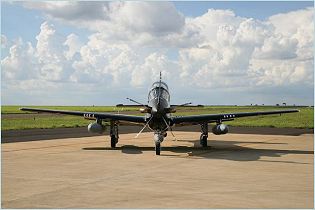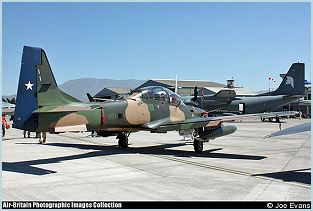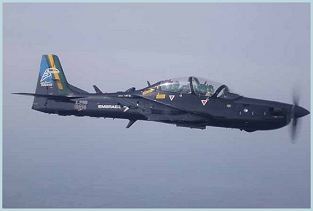EMB314 Super Tucano Embraer
| a | ||||||||||||||||||||||
|
Super Tucano EMB 314 Embraer trainer light attack aircraft
|
||||||||||||||||||||||
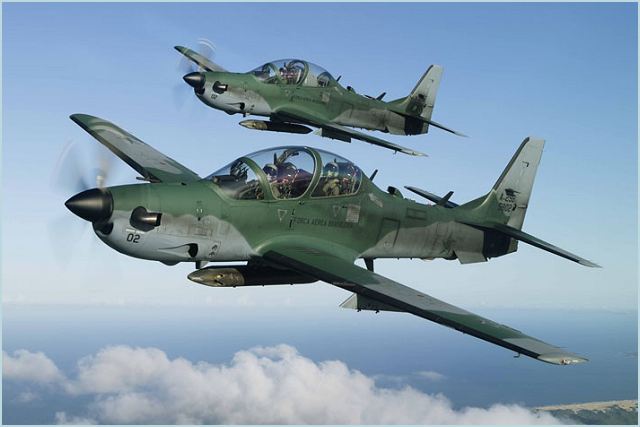 |
||||||||||||||||||||||
|
|
||||||||||||||||||||||
|
The Super Tucano EMB 314 is turboprop trainer aircraft designed and maunfactured by the Brazilian Company Embraer which can be used also for light attack, counter insurgency , close air support, aerial reconnaissance missions. When Embraer introduced the Tucano twenty years ago, it completely revolutionized the concept of trainer and light attack aircraft. Today, the Super Tucano continues this revolution. A single-engine, multi-purpose military aircraft, the Super Tucano is the perfect combination of turboprop efficiency and fourth-generation avionics and armament systems. It delivers both training and operational effectiveness at low acquisition and operating costs. With a service life of 18,000 hours for typical training missions or 12,000 flying hours in operational environments, depending on mission loads and utilization, the Super Tucano is a high-performance aircraft whose operational costs are low due to improved logistics, enhanced system reliability and state-of-the-art engineering. |
||||||||||||||||||||||
| Variants | ||||||||||||||||||||||
|
- A-29A: Single-seater for attack and armed reconnaissance (on interdiction tasks), attack and cover (on close air support tasks), able to intercept and destroy low performance aircraft.
- A-29B: Twin-seater for the same tasks as the single seat version, also used in training and advanced aerial control (on monitoring tasks). |
||||||||||||||||||||||
| Technical Data | ||||||||||||||||||||||
| Design | ||||||||||||||||||||||
|
The aircraft’s structure is corrosion-protected, and the side-hinged canopy has a windshield capable of withstanding a bird strike at 270 kts.
|
||||||||||||||||||||||
| Avionics | ||||||||||||||||||||||
|
The all-glass cockpit of the Super Tucano EMB 314 provides a fourth-generation Human-Machine Interface (HMI) designed to minimize pilot workload by optimizing all tasks (tracking, interception, support, etc.). State-of-the-art avionics and systems have been incorporated into each aircraft. Leading edge in-flight virtual simulation technology allows student pilots to increase their mission effectiveness and information management and situational awareness skills to cope with the new operational scenarios ahead.
The state-of-the-art avionics suite includes: • Full Hands-On Throttle and Stick (HOTAS) technology • Laser INS with GPS Navigational System • Computerized Attack Modes (CCIP, CCRP, CCIL, etc.) • Head-Up Display (HUD) with Up-Front Control Panel (UFCP) • Two liquid crystal Active Matrixes Color Multi-Function Displays (CMFD) • Integrated Radio Communication and Navigation • Tactical V/UHF with provisions for data links • Video Camera/Recorder • Automatic Pilot with embedded mission planning capability • Forward-Looking Infrared (FLIR) • Provisions for night-vision goggles The Super Tucano also features innovations such as an environmental control system designed to assure crew comfort and an On-Board Oxygen Generating System (OBOGS). It is also equipped with Martin-Baker MK-10LCX ejection seats, featuring a three-mode ejection sequential device. The complete customized virtual radar training can be managed through an embedded data-link system that also handles virtual RWR (Radar Warning Receiver), ACMI (Air Combat Maneuver Instrumentation) and virtual BVR (Beyond Visual Range) missiles, among other simulation features. Tailored to operate day and night in the most hostile environments, the Super Tucano is capable of receiving and transmitting data through its state-of-the-art data-link systems. Sensor images, including target data, are readily received or relayed to Command and Control stations, both on the ground and in the air, and to other combat aircraft in the operational theater. A full range of countermeasures includes jammers, flares, chaff, armor protection and state-of-the-art provisions such as MAWS (Missile Approach Warning System) and RWR (Radar Warning Receiver). |
||||||||||||||||||||||
| Propulsion | ||||||||||||||||||||||
|
The Super Tucano EMB 314is powered by a 1,600 SHP, FADEC-controlled PWC PT6A-68C Pratt & Whitney turboprop engine, while the Super Tucano’s airframe has been designed with the latest generation technology and computer-aided tools to withstand +7G/-3.5G loads. The EMB-314 can fly at the rate of 24m per second. The maximum and cruise speed of the aircraft are 530km per hour and 593km per hour, respectively. The range and service ceiling of the Super Tucano are 4,820km and 10,670m respectively. Its maximum endurance is six hours and 30 minutes. The aircraft weighs around 3,020kg and its maximum take-off weight is 5,200kg. The fuel capacity is 695l, which gives a range of over 1,500km and endurance of 6hrs 30mins.
|
||||||||||||||||||||||
| Armament | ||||||||||||||||||||||
|
The Super Tucano EMB 314 is fitted with a pair of .50-caliber machine guns and can be configured with additional under wing armament stations. The Super Tucano has five hardpoints for carrying weapons, and is capable of carrying a maximum external load of 1,500kg. The aircraft is armed with two wing-mounted 12.7mm machine guns with a rate of fire of 1,100 rounds a minute and is capable of carrying general-purpose bombs and guided air-to-air and air-to-ground missiles. Brazilian AF aircraft are armed with the MAA-1 Piranha short-range infrared guided air-to-air missile from Orbita.
|
||||||||||||||||||||||
| Specifications | ||||||||||||||||||||||
|
||||||||||||||||||||||
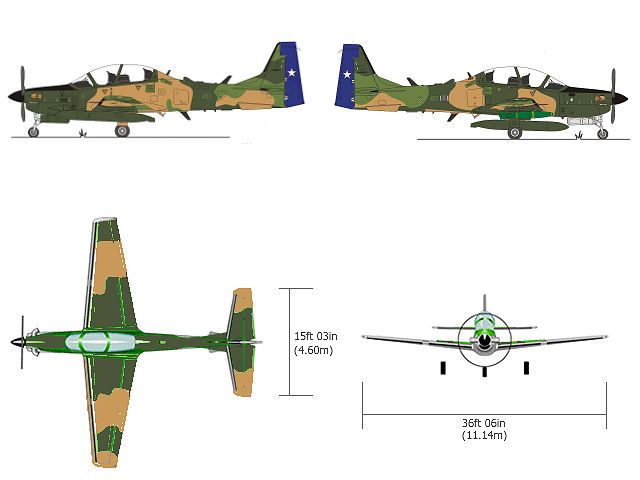 |
||||||||||||||||||||||
|
||||||||||||||||||||||
| {gallery}south_america/brazil/other_aircraft/emb_314_super_tucano/pictures{/gallery} | ||||||||||||||||||||||



























